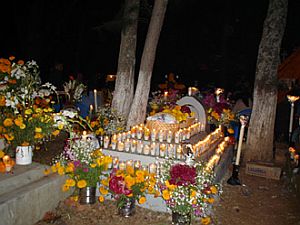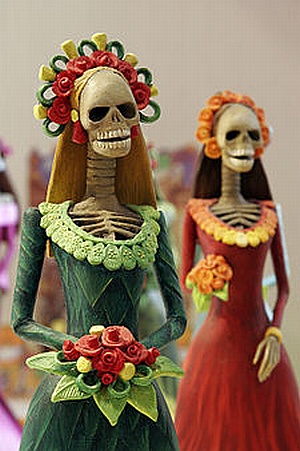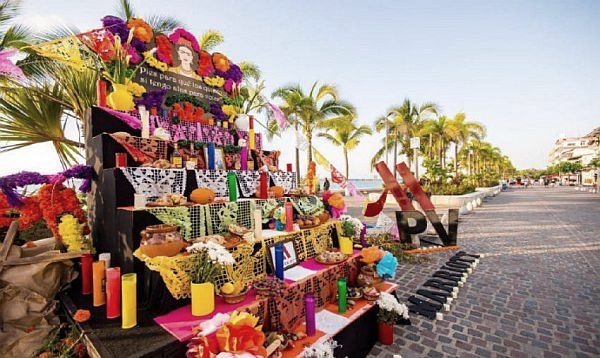Puerto Vallarta, Mexico - The oldest cemetery in the city lies behind white gates at the top of a hill. Outside, vendors are selling little vases of red flowers, armfuls of long white ones and traditional orange marigolds to lay on a loved one's gravestone. They're also doing a brisk business in plastic-covered portraits of Jesus or Mary set in paper wreaths.
It's Dia de Los Muertos, Day of the Dead, when people across Mexico celebrate the idea of their late friends and relatives coming back for a visit. The celebration runs from late October to Nov. 2 and encompasses the Catholic holidays All Saints' Day (Nov. 1) and All Souls' Day (Nov. 2).
 |
Inside the 5 de diciembre cemetery, sun-baked white gravestones are laden with the flowers and wreaths, along with candles to help light the Dead's way back to the land of the living. Families sit around talking and having little picnics at grave sites while a priest in white robes leads prayers in the gazebo at the center.
Just outside the cemetery gates, the parade is getting started. The "Death is Alive" procession is a fun, hot, rather sloppy affair with lots of stops and starts and more than a little hurry up and wait. Pretty girls on horses, Mariachi bands, a rider with a wide sombrero and wider lasso make their way down the cobblestone streets of El Centro to the Malecón (seawall) and wind up at the main square.
Skeletons are everywhere.
Some walk along the parade towering above on stilts and other tiny ones - little kids - are carrying banners and flags in the procession. In the crowd, plenty of blue-eyed blonds and at least one group of Japanese men have white paint, dark eyes, swirls and stitches painted on their faces. Lots of people have only one side of their face decorated to signify life and death.
"We never used to paint our faces here. It's not part of our tradition," says Bizarro. "It's spreading because of social media."
 |
Before being conquered by the Spanish, Mexico's indigenous peoples believed in a complex hierarchy of life after death that rewarded those who died prematurely, for example, being sacrificed to keep the gods happy and to keep the prosperity rolling. "Nowadays, it's a fusion of both cultures," says Bizarro. "Everything is a mix here."
As the indigenous rituals and Spanish Catholicism became one, bloody sacrifices were replaced with sweet bread, Pan de Muerto, which has two strips of dough across the top to signify bones.
It's common to leave some Pan de Muerto on the altars that hold the ofrendas (offerings) representing earth (food), wind (paper flags), water (to quench the soul's thirst) and fire (candles). You also leave sugar skulls and some of the loved one's favorite things to enjoy while they're back visiting.
People erect altars in their homes and in public spaces. At the Marriott, the staff has set up a few of their own colorful displays. Guests on their way to the beach or the giant infinity pool stop to admire the altars for a kindly looking children's singer, the founder of the hotel chain who apparently had a fondness for cheese sandwiches (on white) and a pretty little girl whose offerings include a cupcake with pink icing, an open bag of Doritos, and three Barbie dolls.
In the main square downtown, you meet other dearly departed Mexicans. Some you may already know, such as artist Frida Kahlo, whose offerings include a bottle of Crown Royal. Others, you're just getting to know, such as Maria Sabrina, an indigenous healer whose altar is topped with a picture of her smoking a joint. "She got Lennon high," a man passing by tells us helpfully.
You feel pretty enlightened yourself, wandering around, soaking up Mexican culture on a warm November evening, surrounded by thousands of skeletons happily celebrating life on the Day of the Dead.
Jennifer Allford was a guest of Marriott Puerto Vallarta Resort & Spa, which didn't review or approve this article.


